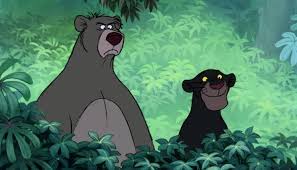
The Jungle Book (1967) Dir, by Wolfgang Reitherman

Disney’s The Jungle Book is a film of young boy trying to prove he can survive in the jungle whilst being persuaded by a cast of animals to return to human life. Mowgli is defiant that he belongs in the jungle but the inherently conservative, and ultimately racist, message of the film is the need to stick to your own kind.
The simple naivety of Baloo also gives the child audience of the film a way of understanding the complexity of the social and cultural messages that are being proposed by the film. Baloo doesn’t understand the reasons Mowgli has to leave the jungle which leads to Bagheera’s exposition of the facts to the audience. Baloo’s tolerance of Mowgli as a jungle dwelling creature is treated by Bagheera as senseless, gesturing that liberal ideas lack understanding. Baloo feels he can raise Mowgli as his own child, yet doesn’t understand the improbability of this. He has already exemplified he is incapable of this after Mowgli is taken from him by the monkeys. This presents Baloo as lacking intelligence and diligence which shows a criticism of the perceived liberal agenda of the time. The Bear Necessities song is key in exemplifying this as it shows the perceived social liberal as not worrying about the complex societal issues of the period. Bagheera is represented as a more conservative, serious figure in the film. However, he also shows a lack of diligence in his attempts to protect Mowgli, which seem to be an oversight in the films allegory of government versus American counter culture in the 1960s in the form of Bagheera and Baloo. This is particularly emphasised by Baloo partaking in singing and dancing which is contrasted with Bagheera’s lack of spontaneity and charisma.
The scene in which Mowgli visits King Louie is key to interpreting this point of social allegories. Ironically, Louie wants to become more human, as opposed to Mowgli who aspires to an animal. Monkeys have historically been used as racist stereotypes to represent black people, and as Louie’s singing and dancing imitates African American stereotypes (such as scat singing), one can deduce Louie is a racist stereotype. This is additionaly problematic as the character is named after black singer Louis Armstrong, yet voiced by white actor Louis Prima. As Louie expresses a desire to be more human, Disney suggests that black people are “less human” than white people. Although Baloo and Bagheera are representative of other people found within society, they aren’t inherently racist symbols as the monkey anthropomorphism is. This is because panthers and bears don’t have the same level of racial connotations as monkeys have. The whole basis of this scene operates under the assumption of human supremacy over all other species of animal due to its level of intelligence. However, the fact that Mowgli doesn’t possess the secret of fire puts him at parity with the animals. Bagheera refutes this later by saying ‘associating with those undesirable, scatter brained apes. I hope Mowgli learned something from that experience.’ This again links to ideas of segregation and keeping races separate. The effect of using animals to represent these views is a subtle way of indoctrinating the intended child audience to absorb the ideas in a simple manner.
Order is only restored to the narrative when Mowgli finds himself attracted to the female human and leaves the jungle. Thus the film ends in a classic Westernised manner of heteronormative romance, and in this case racial normative romance, as Mowgli finally realises he belongs inside the human realm.